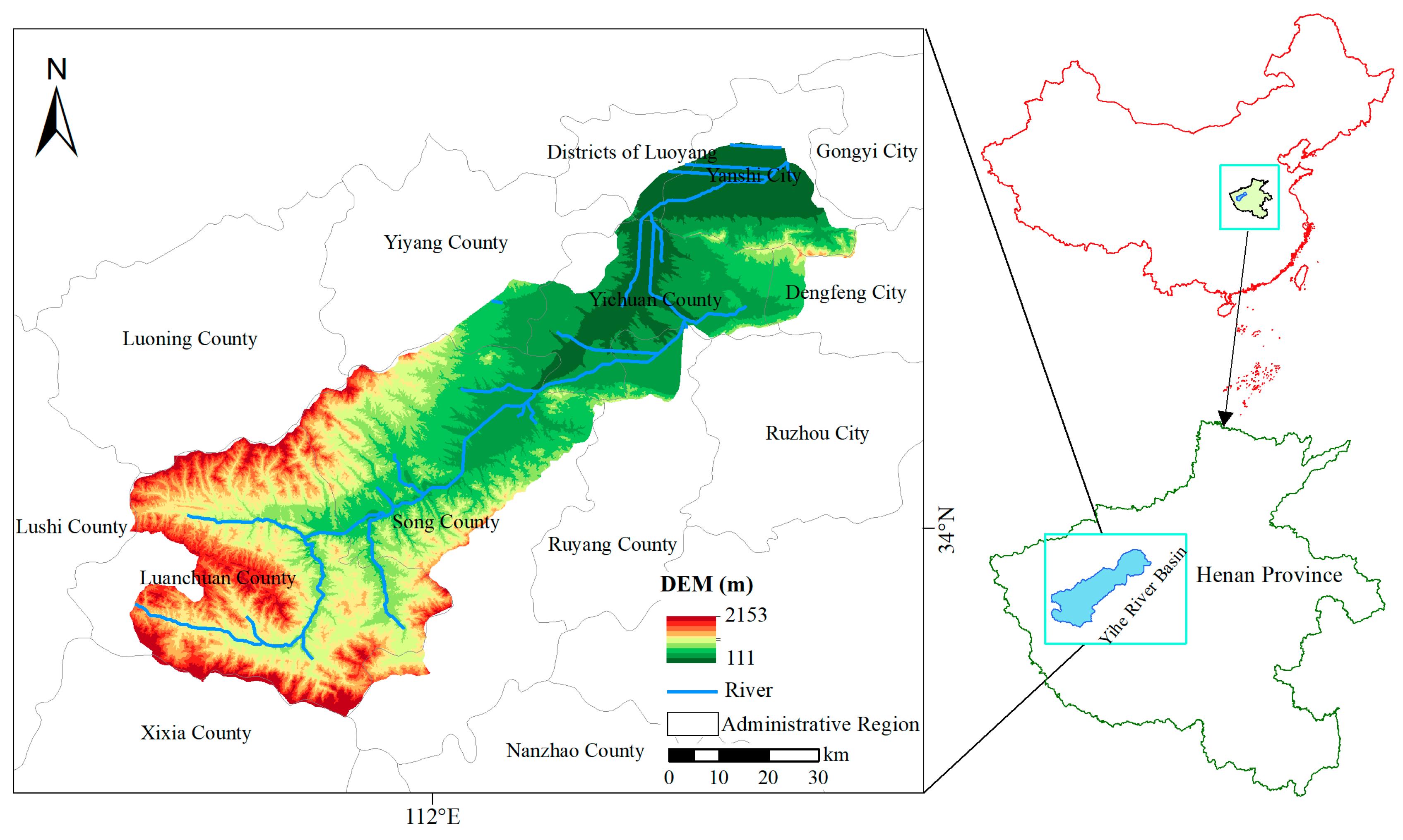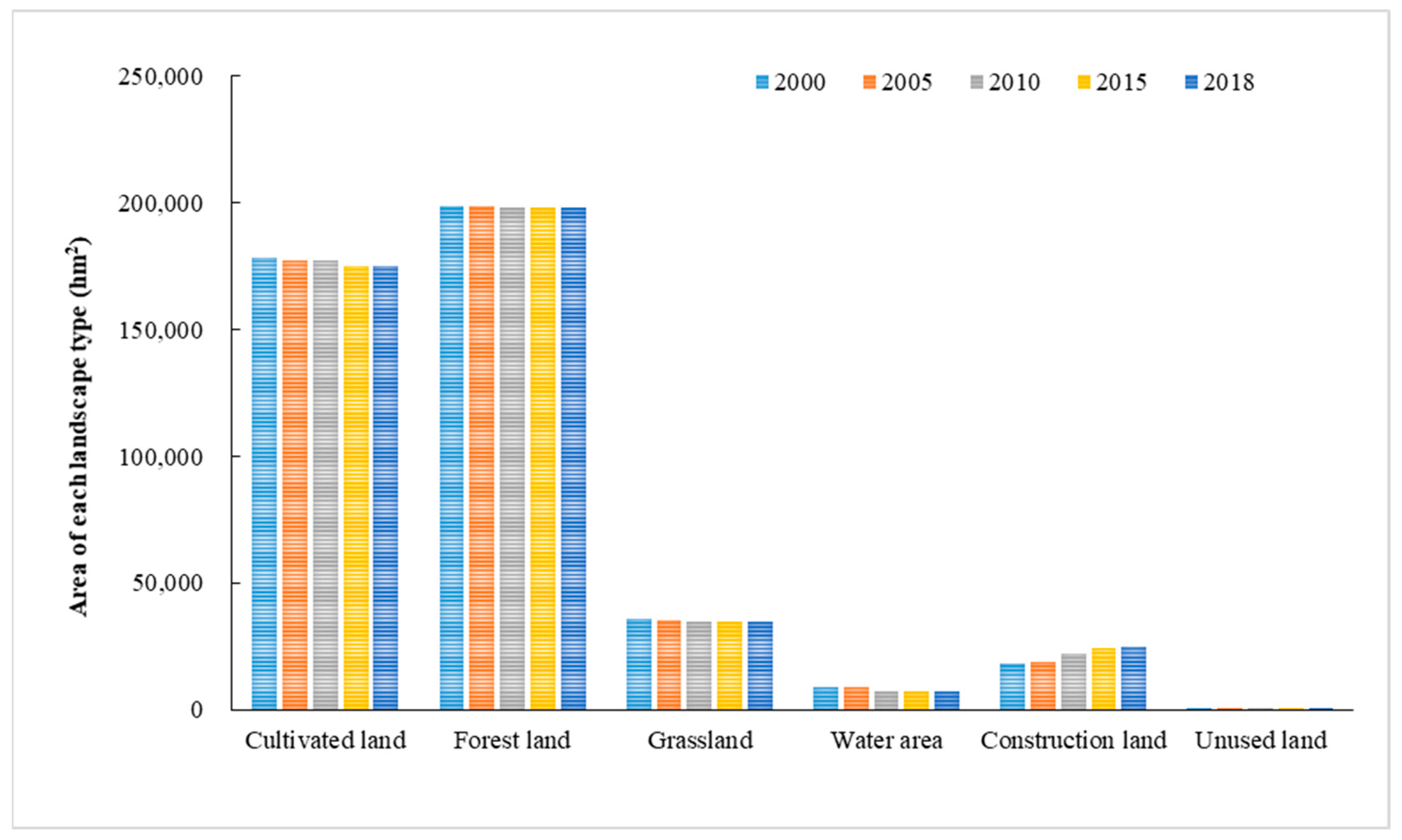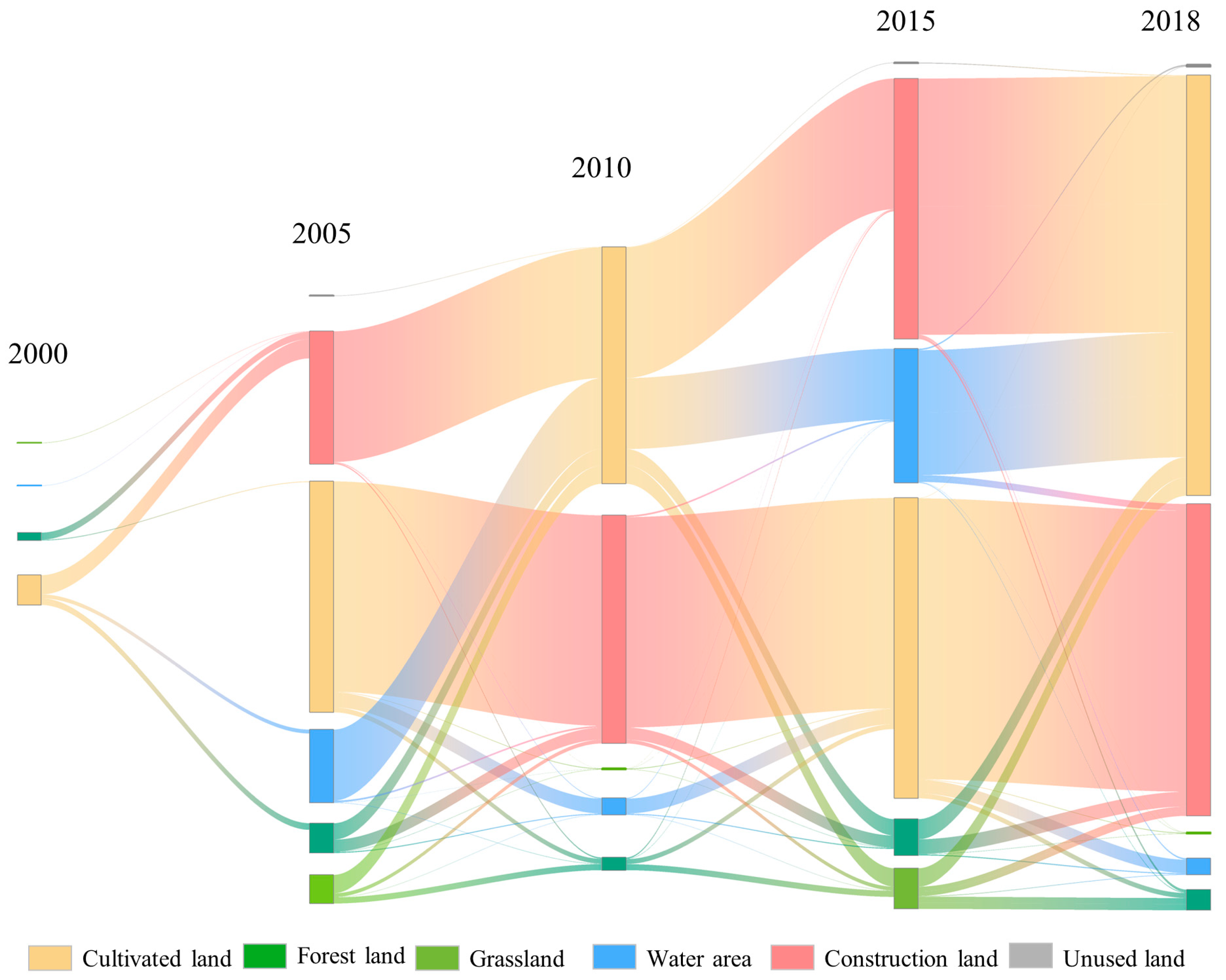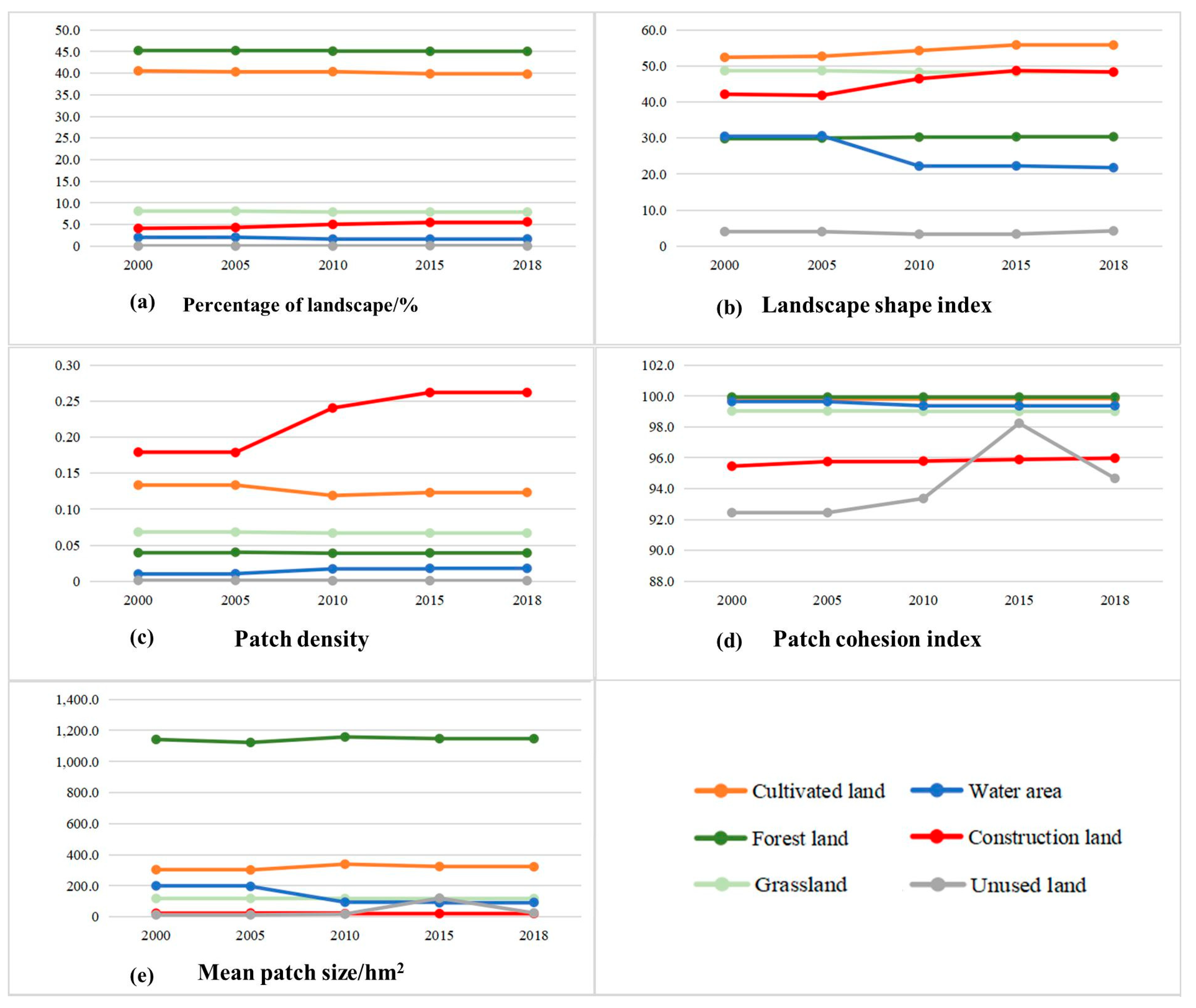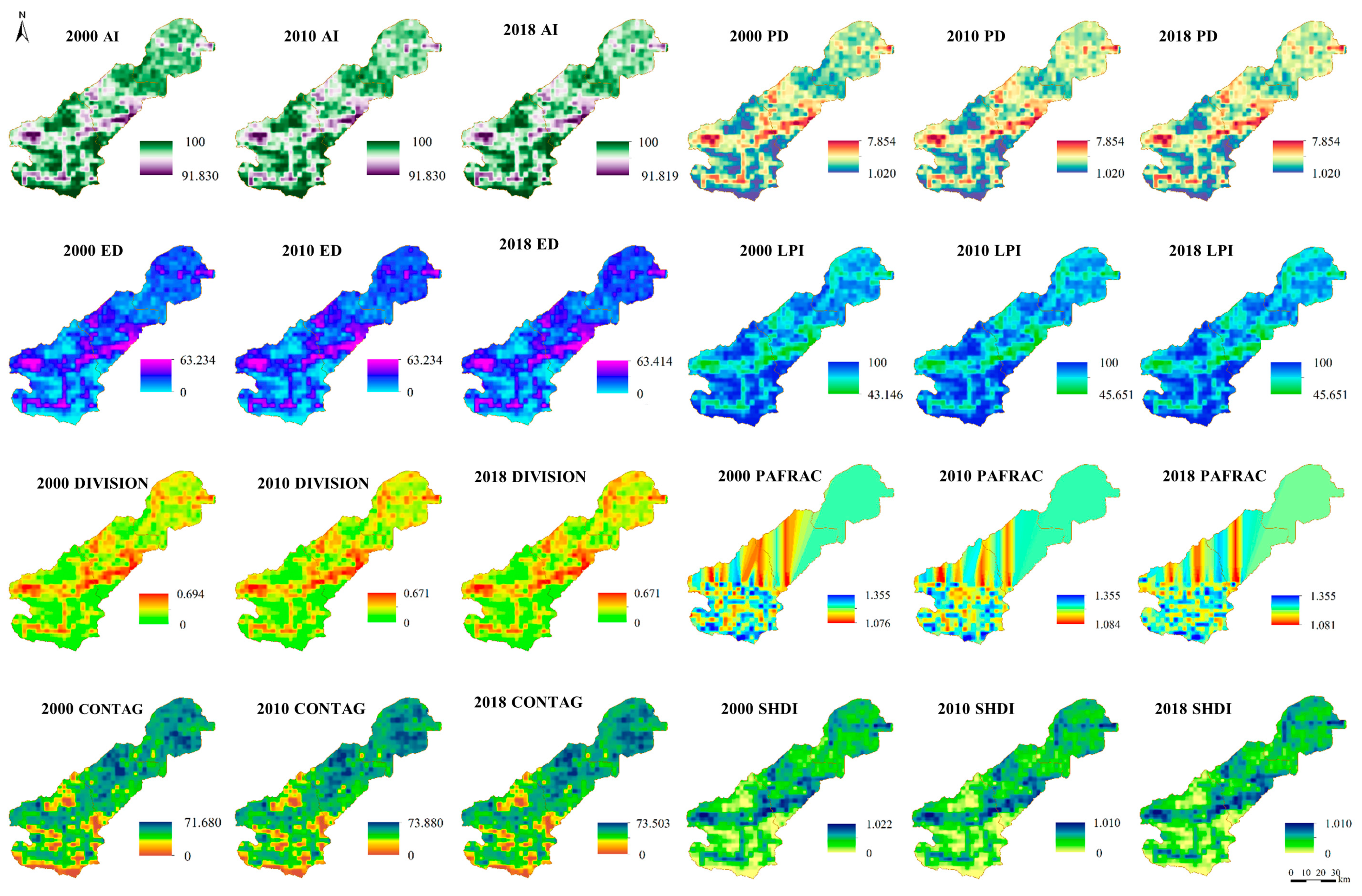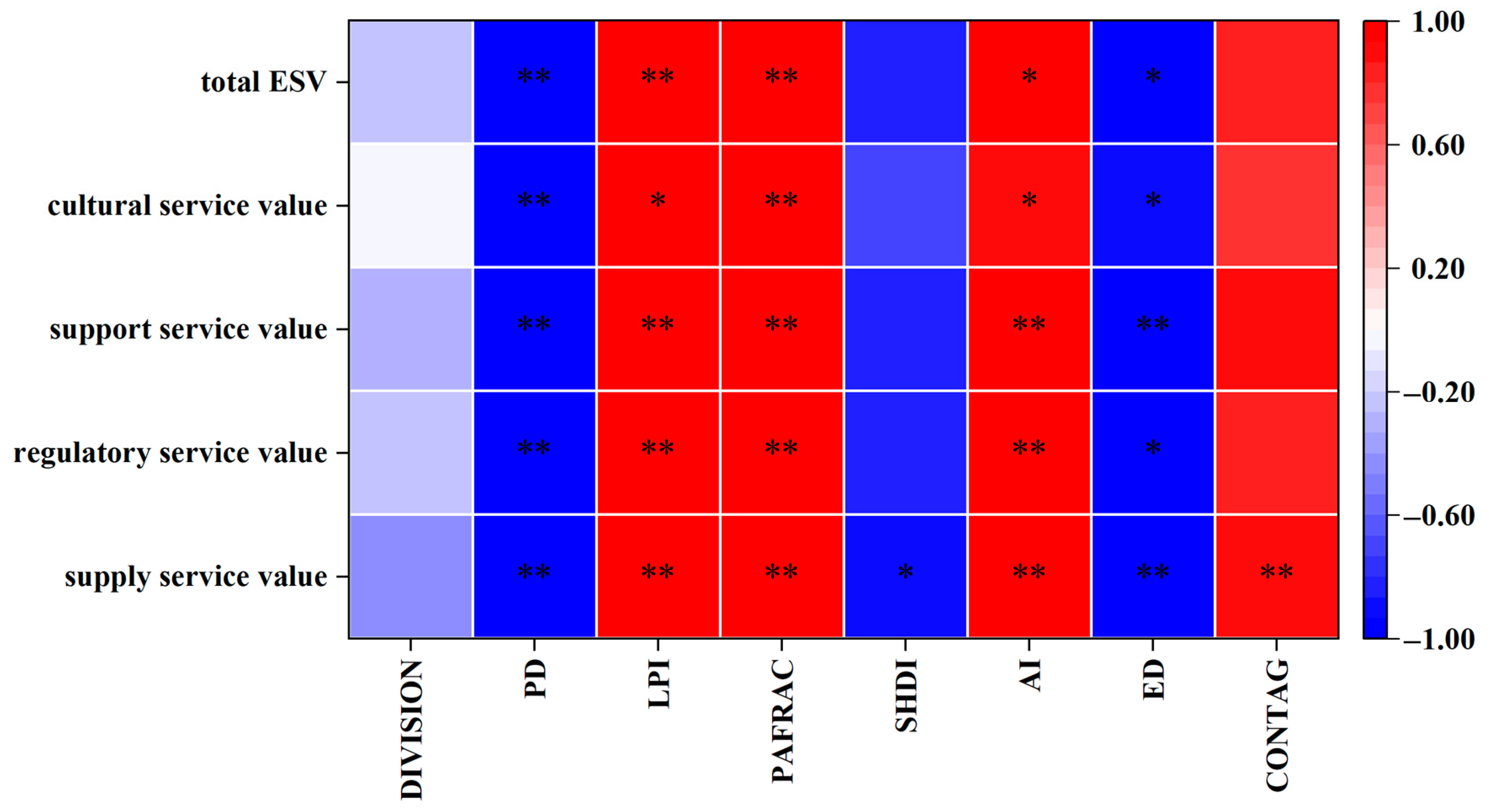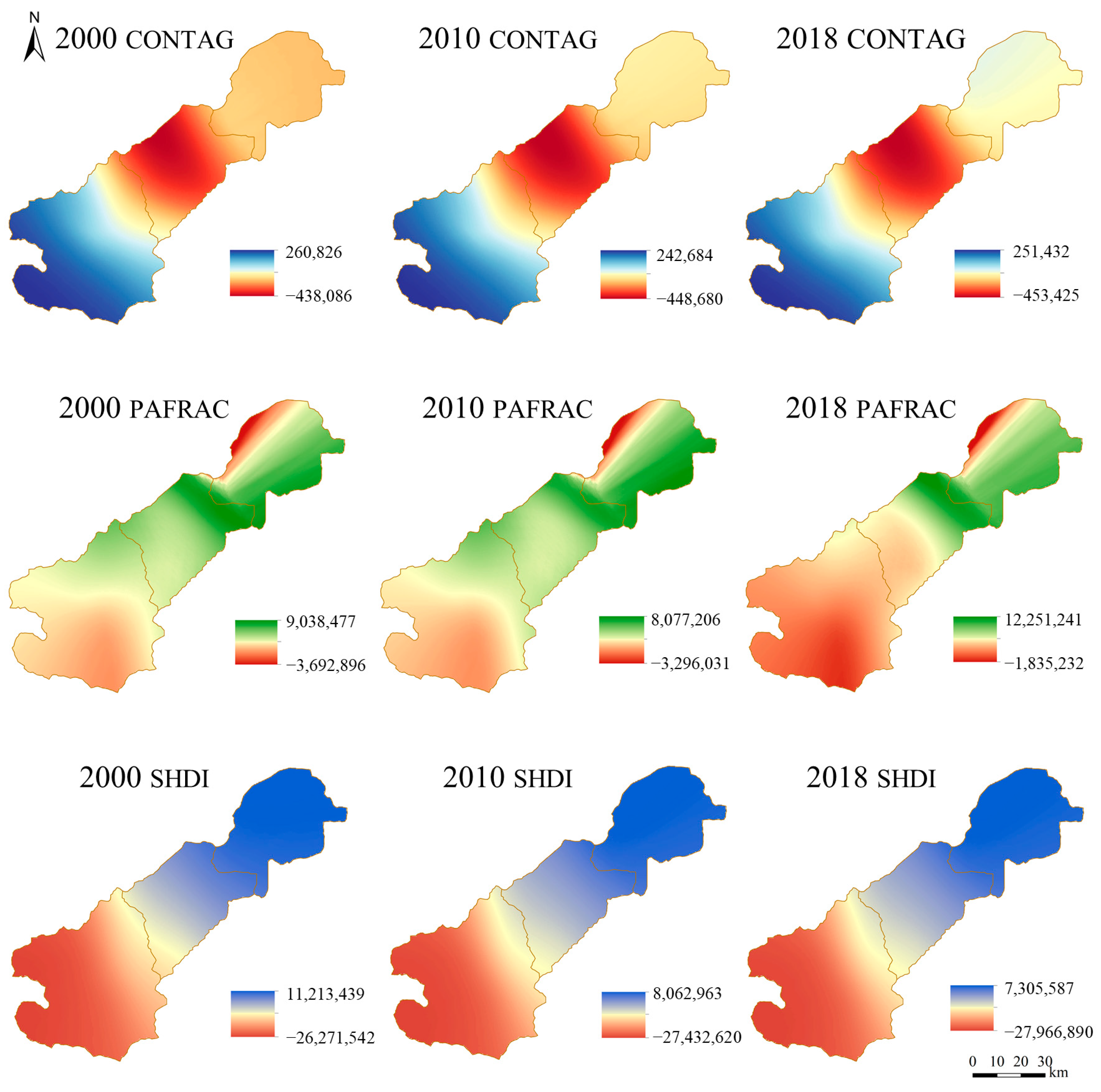1. Introduction
Ecosystem services encompass the products and functions of ecosystems that enhance human well-being and contribute to both survival and the overall quality of life [
1], including provisioning services, regulating services, cultural services, and supporting services. Ecosystem service value is the ecological service benefits that humans derive from ecosystems [
2], as well as the expression of ecosystem functions and utilities [
3], which is abbreviated throughout as ESV. Landscape patterns, involving the spatial arrangement and diverse sizes and shapes of landscape elements, serve as a crucial metric in assessing the quality of regional ecological environments [
4]. The dynamic changes in landscape patterns record the interactive process between human activities and the natural environment, specifically manifesting as changes in land use conditions [
5]. Land use is an important foundation for regional human activities and economic development. With the development of technology and the continuous acceleration of urbanization, people’s land use intensity is increasing, and the impact on the ecological environment is growing. As per the 2005 Millennium Ecosystem Assessment report by the United Nations, more than 60% of ecosystem services have undergone degradation over the last 50 years [
2]. Extensive human activities, particularly rapid urbanization [
6] and coal mining [
7,
8], significantly impact the value of ecosystem services by causing substantial changes in landscape patterns and ecosystems. Therefore, examining the influence of alterations in landscape patterns on ESV and comprehending their dynamic shifts can aid in determining both the losses and gains within the ecological environment. This understanding serves as a scientific foundation for fostering basic economic development and implementing sustainable landscape management practices [
9,
10].
Heterogeneous landscapes affect the flow of matter and energy in ecosystems and therefore control ecosystem processes [
11,
12]. Changes in landscape structure will interfere with these ecosystem processes, resulting in the degradation of ecosystem functions and changes in ESV [
13,
14]. Dynamic changes in landscape patterns are closely related to ESV [
15,
16]. In recent years, research on the connections between ecosystem services and landscape patterns has become increasingly popular for large-scale areas such as cities [
17,
18,
19,
20], river basins [
21,
22,
23], wetlands [
24,
25,
26], and coastal zones [
27]. Additionally, researchers have focused on small-scale areas, such as central urban areas [
28], ecological protection areas [
29,
30], forests [
31,
32], farmlands [
33,
34], citrus orchards [
35], and other areas. Existing studies have found that the contributions of different landscape types to ESVs vary [
36] and different patterns of landscape changes may have positive or negative impacts on ESV. In the European Alps and New Zealand hill country, Vigl et al. [
36] and Tran et al. [
37] have respectively explored the correlations between landscape structure and the provision of ecosystem services. The alteration of landscape patterns significantly influences the provision of ecosystem services, given that distinct landscape structures yield varying types and quantities of such services. In the Bay Area and Zhoushan Islands, Cao et al. [
38] and Tong et al. [
39] investigated alterations in landscape patterns and ESV characteristics. Their findings indicate that the reciprocal transformation among various landscape types enhances the diversity of landscapes per unit area in the studied region, consequently resulting in an overall increase in the total ESV. However, Xu et al. [
40] found in their studies in Wenchuan County that not all changes in landscape patterns cause variations in ecosystem services.
Additionally, some studies have found that changes in landscape patterns influence the landscape index, and different landscape indexes have dissimilar losses and benefits to ESVs. For example, Mitchell et al. [
41] and Grêt-Regamey et al. [
42] demonstrated how landscape fragmentation affects ecosystem services by modifying the configuration and spatial arrangement of landscape patches. Zheng et al. [
43] conducted a study on the ESV in the South Jiangxi area from 2000 to 2018, revealing a positive correlation between the ESV and the contagion index, and a negative correlation with the Shannon diversity index. Their findings suggest that when landscape types exhibit a greater diversity, their aggregation increases, contributing positively to the overall enhancement of ESV. Wen and Li [
44] analyzed Guizhou’s land use change patterns and its ESV and concluded that rising diversification and diminishing fragmentation positively influence regions characterized by high-value landscape types. However, in areas with low-value landscape types, the opposite effect is observed.
Numerous studies have examined the relationship between landscape patterns and ESVs via correlation analyses, but most of them ignore the spatial heterogeneity of variables. Changes in landscape patterns are spatially heterogeneous, so when analyzing the correlation between landscape pattern indexes and ESV changes, the spatial characteristics of variables should be fully considered to reflect the spatial changes of the impacts. Additionally, different landscape types lead to dissimilar changes in landscape patterns, which have varied effects on ecosystem services. Therefore, no consensus exists on the relationship between different landscape pattern indexes and ESV, especially when the effects of time changes or space changes are considered. In view of this, by considering temporal changes or spatial heterogeneity, the relationships between landscape patterns and ESV could be fully identified to support landscape planning.
Situated in the western region of Henan Province, the Yihe River Basin has been influenced by human activities for an extended period due to its early development. It boasts diverse ecosystem types and abundant resources, thus holding considerable ecological value. The importance of the Yihe River Basin is reflected in its provision of water resources to local communities, agricultural support, and promotion of economic activities. The river has a profound impact on local sustainable development and human livelihoods. As a result of these characteristics, the Yihe River Basin serves as a pivotal study area, exemplifying the impact of landscape pattern changes on ESVs. Although the existing research methods on the response mechanism of ESV caused by changes in watershed landscape patterns are relatively mature, they are mostly concentrated in the Yangtze River, Yellow River Basin, and their tributaries [
22,
45,
46,
47,
48,
49,
50]. On the contrary, little attention has been paid to the empirical analysis of the relationship between landscape patterns and ESVs in the typical mountain–hill–plain areas with abundant natural resources in the Central Plains [
51], which need further study. To sum up, this research analyzes the relationship between landscape patterns and ESVs in the Yihe River Basin spanning from 2000 to 2018 from the perspective of spatiotemporal variation. Our research aims to achieve three primary goals: (1) analyze the spatiotemporal variation in landscape patterns and ESV in the Yihe River Basin; (2) examine the relationship of temporal changes in landscape pattern indexes and ESV using Pearson correlation coefficients; and (3) explore the relationship of spatial variations in landscape pattern indexes and ESV through a geographically weighted regression. This research contributes to broadening our knowledge of the current state of ecosystem services in the region, offering a valuable scientific reference for future sustainable resource utilization, landscape planning, and ecological protection endeavors.
4. Discussion
4.1. The Factors of Ecosystem Service Value and Landscape Pattern Changes
The existing literature [
69,
70,
71,
72,
73] indicates that an expansion in construction land results in a decline in ecosystem service value (ESV). Additionally, reductions in water area, cultivated land, and forest land also contribute to a decrease in ESV. Variations in economic development and land use patterns across different study regions exert diverse impacts on ESV. Wang et al. [
74] found that the ESV showed an upward trend with the economic development of Niulanshan–Mapo Town, Beijing. Cheng et al. [
75] found the differences in ESV dynamic evolution caused by urban land use changes in China’s megacities from 1995 to 2008. The expansion of construction land, driven by urbanization in the Yihe River Basin, is associated with a decrease in ESV, which aligns with the findings of Zheng et al. [
43] and Zou and Zhou [
76]. Throughout the study period, while the area of construction land increased in the Yihe River Basin, the other land cover types exhibited a decreasing trend, with minimal changes in cultivated land and forest land. Cultivated land also contributes to food supply, raw material supply, and forest coverage for climate regulation, and the reduction in this transformation promotes a decrease in regional ESV. However, since 2000, the tourism in the Yihe River Basin has gradually become a pillar industry. Notably, the local government’s promotion of “global tourism” led to the establishment of at least one to two tourist areas and numerous tourist villages in each township, intensifying the impact of human-induced construction factors on the natural landscape. Consequently, the area of forest land decreased, contributing to a lower dominance. Moreover, the construction land in different areas of the whole county continues to increase in spots and lines on a small scale, which continuously destroys the integrity of various existing landscapes. Overall, the surge in the growth of construction land can be attributed to swift socio-economic development. The heightened demand for urban land has hastened urban construction and the continual expansion of central urban areas. In 2005–2010, the area of water decreased due to natural and human factors. Among all land cover types, water areas experienced the greatest decrease in area and proportion. The ESV coefficient of water areas is higher than that of the other land cover types, so the transfer of water areas would reduce the overall ESV. In particular, the transformation to construction land severely lowers the ESV. Overall, the total ESV in the Yihe River Basin experienced a decrease of 319 million CNY from 2000 to 2018. The reduction in water area and the increase in construction land emerged as the primary reasons for the ESV decline. Furthermore, forest land and cultivated land were identified as crucial land cover types for sustaining ESV growth. The increase in construction land comes from the transformation of forest land and cultivated land, and a negative ESV coefficient exacerbates the decrease in ESV. The decrease in water area and percentage of forest cover weakens the ecological function of the watershed and consequently erodes the value of services such as gas regulation, hydrological regulation, and climate regulation. Therefore, the proportion of ecological land use in construction land should be increased while protecting the areas of forest land and water and controlling construction land.
The transformation of the Yihe River Basin’s landscape, as indicated by landscape pattern indexes, results from shifts in spatial structure prompted by various activities, including production and construction. Notably, there was an increase in the coverage of construction land within the overall land composition. Government actions play a pivotal role in shaping both land cover types and the associated ESV. Governmental actions, whether explicit or implicit, notably influence the modifications evident in the landscape configuration. Urban expansion, tourism development, large-scale infrastructure construction, and road network improvements led by the government can cause significant transformations of cultivated land and forestland into construction land and roads, which results in a decline in the LPI and CONTAG values and a rise in the PD and ED values. Road greening, tree planting and afforestation, forest cities, and other governmental measures have increased the proportion of green land, changed the relatively simple landscape structure, and improved the heterogeneity and diversity of the landscape. Under these measures, the SHDI of the landscape increases in the basin. Government measures are a leading factor of landscape pattern changes, which directly or indirectly affect the ESV through policies in the process of social and economic development.
4.2. The Relationships between Landscape Patterns and Ecosystem Service Values
Changes in landscape patterns exert a significant influence on the composition, structure, function, and biochemical processes of regional ecosystems, ultimately leading to fluctuations in ecosystem service value (ESV) [
18,
76]. Utilizing landscape indexes enables us to conduct a quantitative description of the dynamic alterations in landscape patterns within the study area, providing an effective measure of changes in human activity intensity. Ecosystem services are intricately linked to the structure and ecological processes of the ecosystem within specific temporal and spatial scales, and ESV alterations quantitatively reflect dynamic shifts in landscape patterns.
The influence of landscape patterns on ESVs demonstrates specific regional traits [
77]. The relationship between ESVs and landscape pattern indexes fluctuates over various periods, geographical areas, and types of landscapes. In Yanbian Prefecture, Yu et al. [
77] observed a significant positive correlation between the ESV and the AI and CONTAG values, while noting a negative correlation with the PD, LSI, and SHDI values. Zhang et al. [
78] found that the ESV is negatively correlated with division and the SHDI in the typical karst areas of Northwest Guangxi. Liu et al. [
79] found that the increase in aggregation and decrease in the DIVISION value increase the ESV in the Qinling Mountains. In the Guangdong–Hong Kong–Macao Greater Bay Area, Cao et al. [
38] found that lower division degrees are more advantageous for enhancing the overall ESV. Conversely, in the southern bank of Hangzhou Bay, Cen et al. [
80] discovered that richer land use, leading to a more fragmented landscape and a higher level of diversity, is beneficial for improving the overall service value. Hu et al. [
29] found that the ESV was positively correlated with the PD in the area around Tai Lake. Some differences are observed in the impact of landscape pattern indexes on ESVs for different periods, regions, and landscape types. Landscape pattern indexes can characterize the landscape configuration quantitatively and intuitively, but regional differences lead to variances in matrices and the dominant landscape. Equivalent landscape indexes may reflect different spatial pattern characteristics, and their effects on ESVs are different.
Cultivated land and forest land remain pivotal matrix types among the landscape types in the Yihe River Basin between 2000 and 2018. However, due to strong urbanization development and economic activities, the partial transformation of other land types into the construction land aggravates the fragmentation of the landscape and increases the scatter degree. Therefore, the shape becomes more complex. The construction land does not show a patched, concentrated increase, but a sporadic, scattered increase, which continues to encroach on the other land cover types. The expansion of industrial and mining land, tourism land, and urban construction land in the Yihe River Basin has divided the landscape pattern of the ecosystem, resulting in the fragmentation of the natural landscape. It lowers the connectivity of the landscape, destroys the biological habitat, and weakens the support and aesthetic value to result in a lower total ESV. Similar to the findings of Hou et al. [
81], Zhang et al. [
82], and Wang et al. [
83], the PD and ED in the Yihe River Basin have a negative impact on the total ESV during the research period. Moreover, the LPI, PAFRAC, and aggregation degree have a positive impact on the total ESV. Due to population growth and urbanization, the transformation of landscape patterns in this region is primarily driven by human activities [
84]. Therefore, across the period, human activities remarkably shape the connection between landscape patterns and ESVs.
In scrutinizing the relationships between landscape pattern indexes and the ESV, a substantial portion of existing research in the literature overlooks the spatial heterogeneity inherent in landscape pattern variables [
44]. Consequently, it falls short in capturing the influence of spatial alterations in landscape pattern indexes on the ESV. Our study found that in terms of spatial variations, the CONTAG, PAFRAC, and SHDI were noticeably correlated with the ESV. This correlation varies considerably across different regions and shows spatial heterogeneity characteristics. The CONTAG index is positively correlated with the ESV upstream, but negatively midstream and downstream. CONTAG reflects the agglomeration degree of patch types. In the upper basin, forestland prevails as the dominant landscape type, and its clustered distribution contributes positively to enhancing the ESV. Conversely, in the lower basin, the clustering of landscape types associated with lower ESVs hinders the improvement of the overall ESV. The SHDI is negatively correlated with ESVs upstream, but positively midstream and downstream. In the upper basin, the ecosystem thrives, whereas in the middle and lower reaches, it exhibits a comparatively delicate condition. The relationships between the SHDI and ESV reveals that in ecologically complex regions, the higher the SHDI value is, the higher the ESV; conversely, in more fragile ecological areas, the higher the SHDI is, the lower the ESV. The PAFRAC exhibits a positive correlation with ESVs for the most part. The correlation is in agreement with the result for the temporal change, which shows that the PAFRAC has a positive impact on the total ESV.
4.3. Limitations and Implications
This study employed a Pearson correlation analysis to quantify the relationship in temporal changes between ESV and landscape patterns. The geographically weighted regression model was utilized to assess the spatial non-stationarity of the impact of landscape patterns on ESV. Nevertheless, our research has certain limitations. ESV is influenced by a myriad of factors, characterized by complex interdependencies that pose challenges in isolating the singular impact of any one factor without considering others. Due to constraints in data availability, this study focused exclusively on the association between changes in landscape patterns and ESV, lacking a quantitative analysis of the driving mechanisms behind these landscape pattern and ESV changes. Furthermore, the internal dynamics between landscape patterns and ESV were not extensively explored in this study. Future research endeavors could benefit from more sophisticated quantitative methods, considering both natural geographical factors and socio-cultural elements, to further elucidate the intricate relationships among ESV, ecological changes, and landscape patterns. Moreover, the association between landscape pattern indexes and ESV exhibits temporal and spatial inconsistencies in most instances, suggesting a spatiotemporal scale effect in their relationship. The mechanism underlying this spatiotemporal scale effect warrants further exploration in future studies.
Owing to continuous increase in construction land for tourism and urban development in the Yihe River Basin, forest land and other natural landscapes are occupied, which destroys the integrity of the original landscape. The ecological condition within the Yihe River Basin has not witnessed a substantial enhancement. Persistent issues such as altered landscape patterns stemming from changes in land use, diminished forested areas, the expansion of construction zones, and the heightened fragmentation of the landscape persist in a grave manner. Because the original landscape has been transformed into landscape types with a minute or negative ESV per unit area, the ESV has ultimately decreased. The local government consider spatial variations in landscape patterns and ESV holistically in the Yihe River Basin, establish corresponding ecological compensation mechanisms, and carry out regional coordination efforts to support sustainable development. While undergoing ecological protection and economic development in the Yihe River Basin, the protection of green land should be strengthened, the fragmentation of landscape patterns decreased, and the connectivity of the overall landscape pattern in the region enhanced to achieve the reasonable allocation and sustainable development of regional resources. Moreover, increasing the areas of forest land and water area that can provide a higher ESV through policy restriction and economic adjustment remains urgent. These measures include implementing ecological management, constructing scientific and perfect agricultural development pattern, and lowering the landscape fragmentation to further improve land use efficiency.
5. Conclusions
Forestland is the landscape with the greatest dominance. Apart from constructed land, all other types have experienced a decline in area, with the most notable change occurring in construction land.
The fragmentation of the overall landscape has increased, and the landscape diversity and richness have also increased. The aggregation of the landscape shows a downward trend.
Throughout the entire study period, the overall ESV gradually decreased, and the land cover type with the greatest contribution to the ESV is forestland.
In terms of temporal changes, the PD and ED of the overall area are significantly negatively correlated with the total ESVs. The LPI, PAFRAC, and aggregation are significantly positively correlated with the total ESVs.
In terms of spatial variations, the CONTAG, PAFRAC, and SHDI were noticeably correlated with the ESVs. The CONTAG is positively correlated with ESVs upstream, but negatively midstream and downstream. The SHDI is negatively correlated with ESVs upstream, but positively midstream and downstream. The PAFRAC, for the most part, exhibits a positive correlation with ESVs.
The association between landscape pattern indexes and the ESV exhibits temporal and spatial inconsistencies in most instances, suggesting a spatiotemporal scale effect in their relationship. Future investigations should delve into the driving mechanisms behind spatiotemporal changes in landscape patterns, ESV, and their interrelationships.
